Mapping Above-Ground Biomass by Integrating Optical and SAR Imagery: A Case Study of Xixi National Wetland Park, China
Abstract
:1. Introduction
2. Study Site and Materials
2.1. Study Site
2.2. Field Sampling
2.3. Remote Sensing Imagery Acquisition and Pre-Processing
3. Methods
3.1. Classification for Vegetation Covered Land Area
- (1)
- Terra ASTER and Envisat ASAR images were input for the classification. We used both optical and SAR images to improve the classification.
- (2)
- The ROI was selected with the help of high resolution imagery in Google Earth®, containing vegetation, water and other land cover. As for each type of land cover, we selected 12 typical ROIs, where each ROI covered multiple pixels.
- (3)
- The Maximum Likelihood classifier in ENVI 4.8® was used for the supervised classification. The VCLA were retrieved and the classification accuracy was examined via user’s accuracy and producer’s accuracy.
3.2. Calculations of Relevant Variables
3.2.1. VIs Calculation
3.2.2. Accuracy Assessment
3.3. Optical-Imagery-Only Models
- (1)
- Simple regression models. They include the usage of both linear and nonlinear models with single independent data. We generated linear and nonlinear regression models using Curve Estimation in IBM SPSS Statistics 20® (SPSS 20). As NDVI is the most widely used vegetation index, and previous biomass models are mainly based on NDVI, it was used as the only independent variable in the curve estimation.
- (2)
- Multivariable linear regression models. The independent variables include each type of optical remote sensing spectral reflectance and the derived VIs. Ordinary least square (OLS) regression method was applied to select independent variables in SPSS 20 with a p-value equal to or less than 0.05. Variance Inflation Factor (VIF) was calculated to evaluate the potential multicollinearity problem.
- (3)
- BPNN models. BPNN is one of the most popular neural networks method and is an excellent nonlinear fit theory, minimizing a global error between predicted outputs and measured values and used in many remote sensing studies [56,57]. The independent variables include spectral reflectance and VIs. In this step, part of sampling data was used to generate BPNN models for estimating AGB, whereas the rest is used for testing the model accuracy.
3.4. SAR-Only Models
- (1)
- Simple regression models. They include the usage of both linear and nonlinear models with single independent data. The independent data is VV or HH polarized microwave backscatter data. We also generated linear and nonlinear regression models using Curve Estimation in SPSS 20.
- (2)
- Multivariable linear regression models. The independent variables include Envisat ASAR HH/VV data. OLS regression method was also applied to select independent variables in SPSS 20 with a p-value equal to or less than 0.05. VIF was calculated to evaluate the potential multicollinearity.
- (3)
- BPNN models. The independent variables include microwave backscatter data (, ). Also in this step, part of sampling data is used to generate models, whereas the rest is used for testing the model accuracy.
3.5. Combination Models Using Spectral Reflectance and SAR Data
- (1)
- Multivariable linear regression models. The independent variables include Envisat ASAR imagery and VIs. OLS regression method was applied to select independent variables in SPSS 20 with a p-value equal to or less than 0.05. VIF was also calculated to evaluate the potential multicollinearity.
- (2)
- BPNN models. The independent variables include a combination of spectral reflectance, VIs and microwave backscatter data (, ). In this step, part of sampling data is used to generate models, whereas the rest is used for testing the model accuracy.
4. Results
4.1. Classification for Vegetation Covered Areas
4.2. Models and Predictions
- (1)
- In the first column, the predicted AGB results were from NDVI data and NDVI regression models. In the second column, the predicted AGB results were from multivariable linear regression models. The regression models for predicting AGB from NDVI were listed in Table 2(a).
- (2)
- In the first line, the data for predicting AGB were from Terra ASTER images. In the second and the third line, the data were from Landsat ETM+ and HJ-1-B CCD images.
- (1)
- (2)
- In the first column of Figure 8a,b, the optical data combined with SAR data for predicting AGB was from Terra ASTER. And the optical data was from Landsat ETM+ and HJ-1-B CCD in the second and third column respectively.
- (3)
- (4)
- In the second line, the predicted AGB results were predicted from BPNN models.
5. Discussion
5.1. Comparison of Models by Sensor Type
5.2. Comparison of Modeling Methods
5.3. AGB Distribution
6. Conclusions
- (1)
- There exists some potential disagreement between remote sensing data and field inventory. Field sampling was carried out in March and April and early May in 2009. All the images were not acquired in this period, but mainly in March or April in the year 2009. The Envisat ASAR image was acquired in August when the vegetation was in another growing season.
- (2)
- One of the potential reasons that decrease accuracy is that all optical images were resampled to 12.5 m in resolution but the original resolution was 15 m for Terra ASTER, 30 m for Landsat ETM+ and HJ-1-B CCD.
- (3)
- As the curve estimation yielded nonlinear models, Table 2, spectral data and VIs are possibly in nonlinear relation with AGB. This is also addressed in Section 5.2. The accuracy would be improved in multivariable nonlinear regression models.
- (4)
- Differences exist between predicted AGB maps derived from different modeling method and input data. The results should be compared with analysis from other studies, so as to choose better models. Currently there are no AGB studies in this area.
Acknowledgments
Author Contributions
Conflicts of Interest
References
- Kokaly, R.F.; Despain, D.G.; Clark, R.N.; Livo, K.E. Mapping vegetation in Yellowstone national park using spectral feature analysis of aviris data. Remote Sens. Environ. 2003, 84, 437–456. [Google Scholar] [CrossRef]
- Bustamante, J.; Pacios, F.; Díaz-Delgado, R.; Aragonés, D. Predictive models of turbidity and water depth in the Doñana marshes using Landsat TM and ETM+ images. J. Environ. Manag. 2009, 90, 2219–2225. [Google Scholar] [CrossRef] [PubMed]
- Díaz-Delgado, R.; Aragonés, D.; Ameztoy, I.; Bustamante, J. Monitoring marsh dynamics through remote sensing. In Conservation Monitoring in Freshwater Habitats; Springer: Dordrecht, The Netherlands, 2010; pp. 375–386. [Google Scholar]
- Dąbrowska-Zielińska, K.; Budzyńska, M.; Kowalik, W.; Małek, I.; Gatkowska, M.; Bartold, M. Biophysical parameters assessed from microwave and optical data. AEU Int. J. Electron. Commun. 2012, 58, 99–104. [Google Scholar] [CrossRef]
- Zoffoli, M.L.; Kandus, P.; Madanes, N.; Calvo, D.H. Seasonal and interannual analysis of wetlands in South America using NOAA-AVHRR NDVI time series: The case of the Parana Delta Region. Landsc. Ecol. 2008, 23, 833–848. [Google Scholar] [CrossRef]
- Goetz, S.; Dubayah, R. Advances in remote sensing technology and implications for measuring and monitoring forest carbon stocks and change. Carbon Manag. 2011, 2, 231–244. [Google Scholar] [CrossRef]
- Liao, J.; Dong, L.; Shen, G. Neural network algorithm and backscattering model for biomass estimation of wetland vegetation in Poyang Lake area using Envisat ASAR data. In Proceedings of the International Geoscience and Remote Sensing Symposium (IGARSS), Cape Town, South Africa, 13–17 July 2009.
- Zolkos, S.G.; Goetz, S.J.; Dubayah, R. A meta-analysis of terrestrial aboveground biomass estimation using LiDAR remote sensing. Remote Sens. Environ. 2013, 128, 289–298. [Google Scholar] [CrossRef]
- Li, X. Study of urban wetland park development in Chongqing. In Informatics and Management Science VI; Springer: London, UK, 2013; pp. 217–225. [Google Scholar]
- Haase, D.; Larondelle, N.; Andersson, E.; Artmann, M.; Borgström, S.; Breuste, J.; Gomez-Baggethun, E.; Gren, Å.; Hamstead, Z.; Hansen, R.; et al. A quantitative review of urban ecosystem service assessments: Concepts, models, and implementation. Ambio 2014, 43, 413–433. [Google Scholar] [CrossRef] [PubMed]
- Schetke, S.; Haase, D.; Breuste, J.H. Green space functionality under conditions of uneven urban land use development. J. Land Use Sci. 2010, 5, 143–158. [Google Scholar] [CrossRef]
- Kapil, N.; Bhattacharyya, K.G. Spatial, temporal and depth profiles of trace metals in an urban wetland system: A case study with respect to the Deepor Beel, Ramsar site 1207. India. Environ. Pollut. 2012, 2, 51–72. [Google Scholar] [CrossRef]
- Zhang, D.; Jinadasa, K.B.S.N.; Gersberg, R.M.; Liu, Y.; Ng, W.J.; Tan, S.K. Application of constructed wetlands for wastewater treatment in developing countries—A review of recent developments (2000–2013). J. Environ. Manag. 2014, 141, 116–131. [Google Scholar] [CrossRef] [PubMed]
- Lang, M.; Bourgeau-Chavez, L.L.; Tiner, R.W.; Klemas, V.V. Advances in remotely sensed data and techniques for wetland mapping and monitoring. In Remote Sensing of Wetlands: Applications and Advances; Ralph, W.T., Megan, W.L., Victor, V.K., Eds.; CRC Press: Boca Raton, FL, USA, 2015; Chapter 5; pp. 79–118. [Google Scholar]
- Adam, E.; Mutanga, O.; Rugege, D. Multispectral and hyperspectral remote sensing for identification and mapping of wetland vegetation: A review. Wetl. Ecol. Manag. 2010, 18, 281–296. [Google Scholar] [CrossRef]
- Moreau, S.; Bosseno, R.; Gu, X.F.; Baret, F. Assessing the biomass dynamics of Andean bofedal and totora high-protein wetland grasses from NOAA/AVHRR. Remote Sens. Environ. 2003, 85, 516–529. [Google Scholar] [CrossRef]
- Zhao, B.; Yan, Y.; Guo, H.; He, M.; Gu, Y.; Li, B. Monitoring rapid vegetation succession in estuarine wetland using time series MODIS-based indicators: An application in the Yangtze River Delta area. Ecol. Indic. 2009, 9, 346–356. [Google Scholar] [CrossRef]
- Xie, P.; He, B.; Xing, M. Estimation above-ground biomass of wetland bulrush in Qaidam Basin, China, combining regression model with vegetation index. In Proceedings of the 2011 19th International Conference on Geoinformatics, Shanghai, China, 24–26 June 2011.
- Chen, W.; Zorn, P.; Chen, Z.; Latifovic, R.; Zhang, Y.; Li, J.; Quirouette, J.; Olthof, I.; Fraser, R.; Mclennan, D.; et al. Propagation of errors associated with scaling foliage biomass from field measurements to remote sensing data over a northern Canadian national park. Remote Sens. Environ. 2013, 130, 205–218. [Google Scholar] [CrossRef]
- Dillabaugh, K.A.; King, D.J. Riparian marshland composition and biomass mapping using IKONOS imagery. Can. J. Remote Sens. 2008, 34, 143–158. [Google Scholar] [CrossRef]
- Ghioca-Robrecht, D.M.; Johnston, C.A.; Tulbure, M.G. Assessing the use of multiseason QuickBird imagery for mapping invasive species in a Lake Erie coastal Marsh. Wetlands 2008, 28, 1028–1039. [Google Scholar] [CrossRef]
- Davranche, A.; Lefebvre, G.; Poulin, B. Wetland monitoring using classification trees and SPOT-5 seasonal time series. Remote Sens. Environ. 2010, 114, 552–562. [Google Scholar] [CrossRef]
- Moreau, S.; Le Toan, T. Biomass quantification of Andean wetland forages using ERS satellite SAR data for optimizing livestock management. Remote Sens. Environ. 2003, 84, 477–492. [Google Scholar] [CrossRef]
- Grings, F.; Salvia, M.; Karszenbaum, H.; Ferrazzoli, P.; Perna, P.; Barber, M.; Berlles, J.J. Statistical information of ASAR observations over wetland areas: An interaction model interpretation. ISPRS J. Photogramm. Remote Sens. 2010, 65, 77–85. [Google Scholar] [CrossRef]
- Chen, J.; Lin, H.; Huang, C.; Fang, C. The relationship between the leaf area index (LAI) of rice and the C-band SAR vertical/horizontal (VV/HH) polarization ratio. Int. J. Remote Sens. 2009, 30, 2149–2154. [Google Scholar]
- Pandey, U.; Kushwaha, S.P.S.; Kachhwaha, T.S.; Kunwar, P.; Dadhwal, V.K. Potential of Envisat ASAR data for woody biomass assessment. Trop. Ecol. 2010, 51, 117–124. [Google Scholar]
- Dabrowska-Zielinska, K.; Gruszczynska, M.; Lewinski, S.; Hoscilo, A.; Bojanowski, J. Application of remote and in situ information to the management of wetlands in Poland. J. Environ. Manag. 2009, 90, 2261–2269. [Google Scholar] [CrossRef] [PubMed]
- Sun, Y.; Gong, H.; Li, X.; Pu, R.; Li, S. Extracting eco-hydrological information of inland wetland from L-band Synthetic Aperture Radar image in Honghe National Nature Reserve, Northeast China. Chin. Geogr. Sci. 2011, 21, 241–248. [Google Scholar] [CrossRef]
- Gama, F.F.; Dos Santos, J.R.; Mura, J.C. Eucalyptus biomass and volume estimation using interferometric and polarimetric SAR data. Remote Sens. 2010, 2, 939–956. [Google Scholar] [CrossRef]
- Santos, J.R.; Lacruz, M.S.P.; Araujo, L.S.; Keil, M. Savanna and tropical rainforest biomass estimation and spatialization using JERS-1 data. Int. J. Remote Sens. 2002, 23, 1217–1229. [Google Scholar] [CrossRef]
- Collins, J.N.; Hutley, L.B.; Williams, R.J.; Boggs, G.; Bell, D.; Bartolo, R. Estimating landscape-scale vegetation carbon stocks using airborne multi-frequency polarimetric synthetic aperture radar (SAR) in the savannahs of north australia. Int. J. Remote Sens. 2009, 30, 1141–1159. [Google Scholar] [CrossRef]
- Huang, W.; Sun, G.; Ni, W.; Zhang, Z.; Dubayah, R. Sensitivity of multi-source SAR backscatter to changes in forest aboveground biomass. Remote Sens. 2015, 7, 9587–9609. [Google Scholar] [CrossRef]
- Cutler, M.E.J.; Boyd, D.S.; Foody, G.M.; Vetrivel, A. Estimating tropical forest biomass with a combination of SAR image texture and Landsat TM data: An assessment of predictions between regions. ISPRS J. Photogramm. Remote Sens. 2012, 70, 66–77. [Google Scholar] [CrossRef]
- Li, X.; Yeh, A.G.O.; Wang, S.; Liu, K.; Liu, X. Estimating mangrove wetland biomass using radar remote sensing. J. Remote Sens. 2006, 10, 387–396. [Google Scholar]
- Anderson, J.E. Spectral Signatures of Wetlands Plants (350–900 nm); Army Topographic Engineering Center Fort Belvoir VA: Alexandria, VA, USA, 1995. [Google Scholar]
- Shen, G.; Liao, J.; Guo, H.; Liu, J.; Zhang, L.; Chen, J. Wetland vegetation biomass inversion using polarimetric RADARSAT-2 data. In Proceedings of the 2012 IEEE International Geoscience and Remote Sensing Symposium (IGARSS), Munich, Germany, 22–27 July 2012.
- Sexton, R.S.; Dorsey, R.E.; Johnson, J.D. Optimization of neural networks: A comparative analysis of the genetic algorithm and simulated annealing. Eur. J. Oper. Res. 1999, 114, 589–601. [Google Scholar] [CrossRef]
- Baştürk, A.; Günay, E. Efficient edge detection in digital images using a cellular neural network optimized by differential evolution algorithm. Expert Syst. Appl. 2009, 36, 2645–2650. [Google Scholar] [CrossRef]
- Shen, Q.; Liu, K.; Li, S.; Zhang, J.; Jiang, Y.; Ge, Y.; Chang, J. Relationships of plant composition, water level and solar radiation in Xixi Wetland, Hangzhou, China. J. Plant Ecol. 2008, 32, 114–122. [Google Scholar]
- Zhou, H.; Jiang, H.; Zhou, G.; Song, X.; Yu, S.; Chang, J.; Liu, S.; Jiang, Z.; Jiang, B. Monitoring the change of urban wetland using high spatial resolution remote sensing data. Int. J. Remote Sens. 2010, 31, 1717–1731. [Google Scholar] [CrossRef]
- Bonham, C.D. Measurements for Terrestrial Vegetation; John Wiley & Sons: Hoboken, NJ, USA, 2013. [Google Scholar]
- Parresol, B.R. Assessing tree and stand biomass: A review with examples and critical comparisons. For. Sci. 1999, 45, 573–593. [Google Scholar]
- Brown, S. Measuring carbon in forests: Current status and future challenges. Environ. Pollut. 2002, 116, 363–372. [Google Scholar] [CrossRef]
- Wang, Q.; Wu, C.; Li, Q.; Li, J. Chinese HJ-1A/B satellites and data characteristics. Sci. China Ser. D 2010, 53, 51–57. [Google Scholar] [CrossRef]
- Tucker, C.J. Red and photographic infrared linear combinations for monitoring vegetation. Remote Sens. Environ. 1979, 8, 127–150. [Google Scholar] [CrossRef]
- Bannari, A.; Morin, D.; Bonn, F.; Huete, A.R. A review of vegetation indices. Remote Sens. Rev. 1995, 13, 95–120. [Google Scholar] [CrossRef]
- Purevdorj, T.S.; Tateishi, R.; Ishiyama, T.; Honda, Y. Relationships between percent vegetation cover and vegetation indices. Int. J. Remote Sens. 1998, 19, 3519–3535. [Google Scholar] [CrossRef]
- Huang, C.; Shao, Y.; Liu, J.; Chen, J. Temporal analysis of urban forest in Beijing using Landsat imagery. J. Appl. Remote Sens. 2007, 1, 1–12. [Google Scholar] [CrossRef]
- Glenn, E.P.; Huete, A.R.; Nagler, P.L.; Nelson, S.G. Relationship between remotely-sensed vegetation indices, canopy attributes and plant physiological processes: What vegetation indices can and cannot tell us about the landscape. Sensors 2008, 8, 2136–2160. [Google Scholar] [CrossRef]
- Pinty, B.; Verstraete, M.M. GEMI: A non-linear index to monitor global vegetation from satellites. Vegetatio 1992, 101, 15–20. [Google Scholar] [CrossRef]
- Wu, J.; Gao, W.; Tueller, P.T. Effects of changing spatial scale on the results of statistical analysis with landscape data: A case study. Geogr. Inf. Sci. 1997, 3, 30–41. [Google Scholar] [CrossRef]
- Roujean, J.L.; Breon, F.M. Estimating PAR absorbed by vegetation from bidirectional reflectance measurements. Remote Sens. Environ. 1995, 51, 375–384. [Google Scholar] [CrossRef]
- Rundquist, D.; Gitelson, A.; Lawson, M.; Keydan, G.; Leavitt, B.; Perk, R.; Keck, J.; Mishra, D.R.; Narumalani, S. Proximal sensing of coral features: Spectral characterization of Siderastrea siderea. GISci. Remote Sens. 2009, 46, 139–160. [Google Scholar] [CrossRef]
- Gu, Z.; Shi, X.; Li, L.; Yu, D.; Liu, L.; Zhang, W. Using multiple radiometric correction images to estimate leaf area index. Int. J. Remote Sens. 2011, 32, 9441–9454. [Google Scholar] [CrossRef]
- Deng, C.; Wu, C. Examining the impacts of urban biophysical compositions on surface urban heat island: A spectral unmixing and thermal mixing approach. Remote Sens. Environ. 2013, 131, 262–274. [Google Scholar] [CrossRef]
- Chen, J.; Zeng, Z.; Jiang, P.; Tang, H. Deformation prediction of landslide based on functional network. Neurocomputing 2015, 149, 151–157. [Google Scholar] [CrossRef]
- Chen, T.; Chang, Q.; Clevers, J.G.P.W.; Kooistra, L. Rapid identification of soil cadmium pollution risk at regional scale based on visible and near-infrared spectroscopy. Environ. Pollut. 2015, 206, 217–226. [Google Scholar] [CrossRef] [PubMed]
- Treuhaft, R.N.; Siqueira, P.R. The calculated performance of forest structure and biomass estimates from interferometric radar. Wave Random Media 2004, 14, S345–S358. [Google Scholar] [CrossRef]
- Montesano, P.M.; Cook, B.D.; Sun, G.; Simard, M.; Nelson, R.F.; Ranson, K.J.; Zhang, Z.; Luthcke, S. Achieving accuracy requirements for forest biomass mapping: A spaceborne data fusion method for estimating forest biomass and LiDAR sampling error. Remote Sens. Environ. 2013, 130, 153–170. [Google Scholar] [CrossRef]
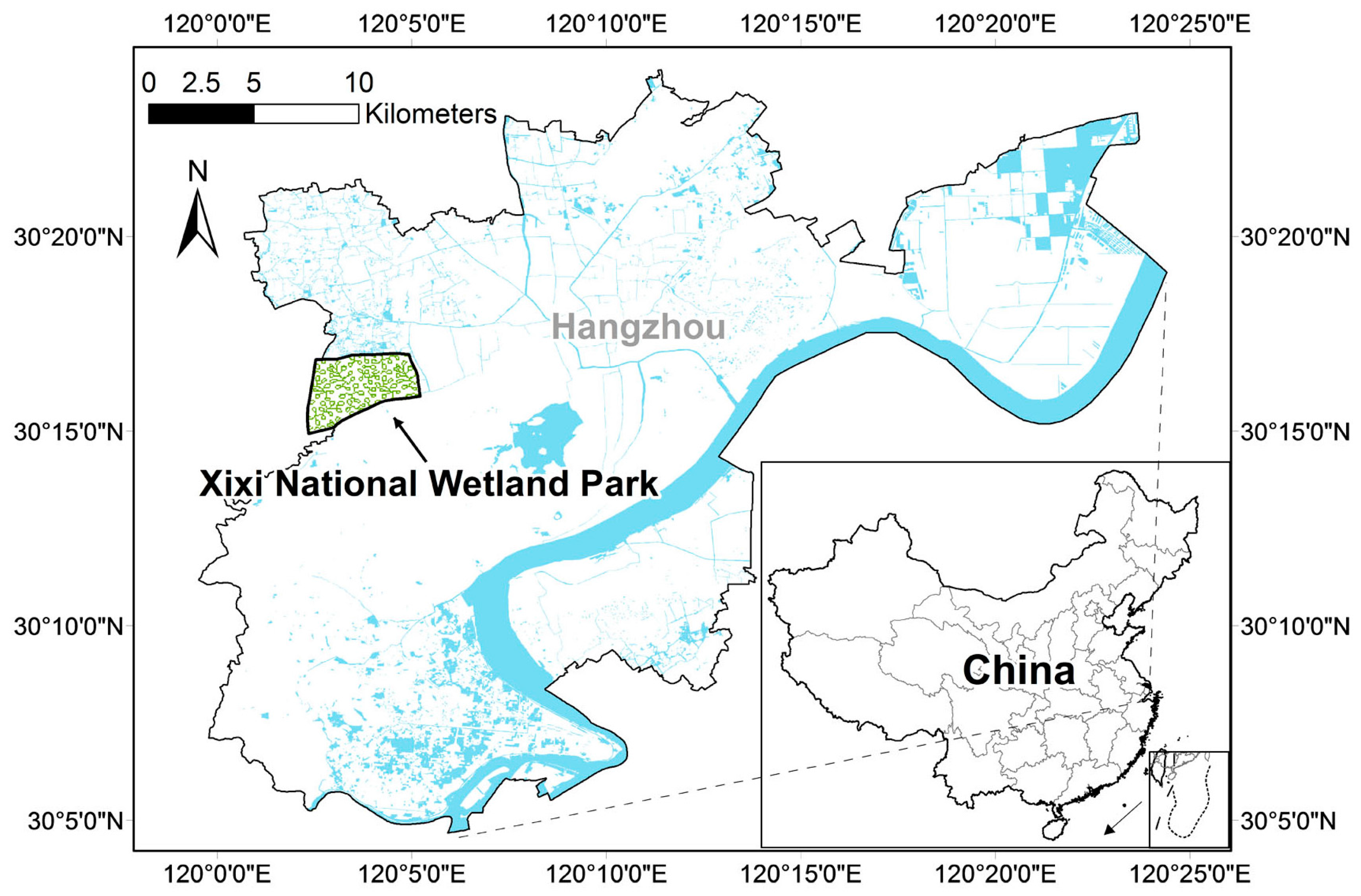
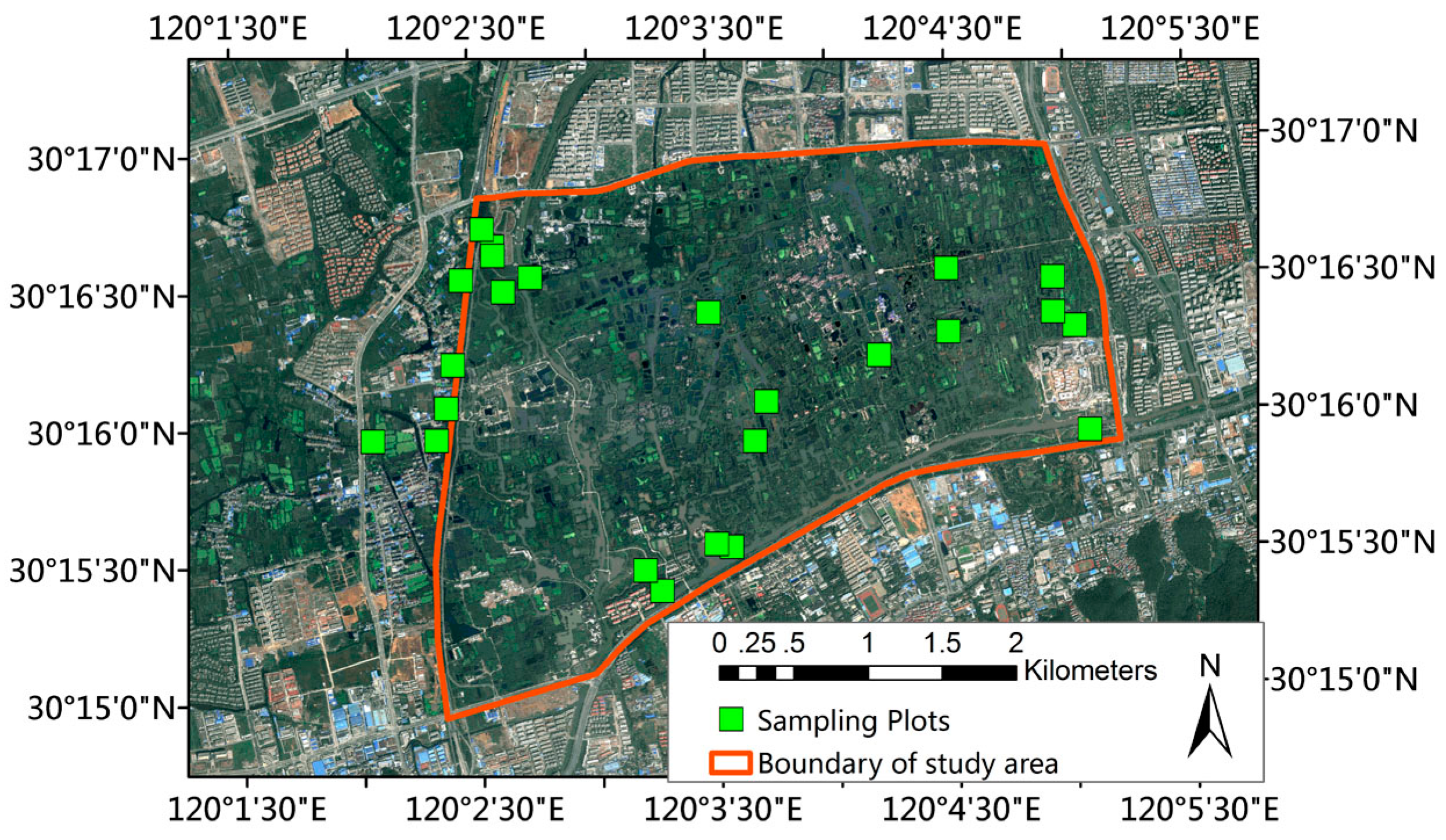
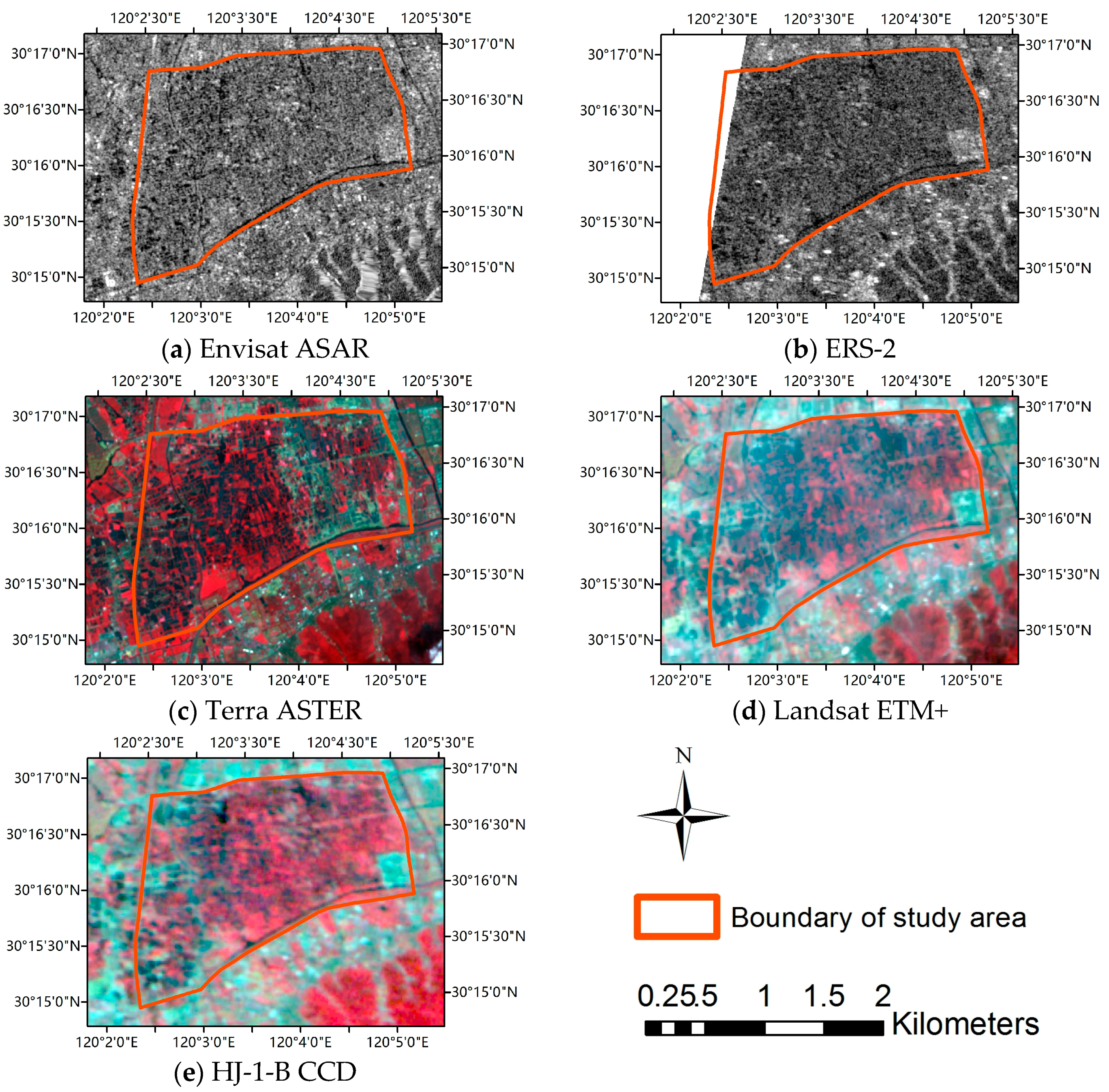
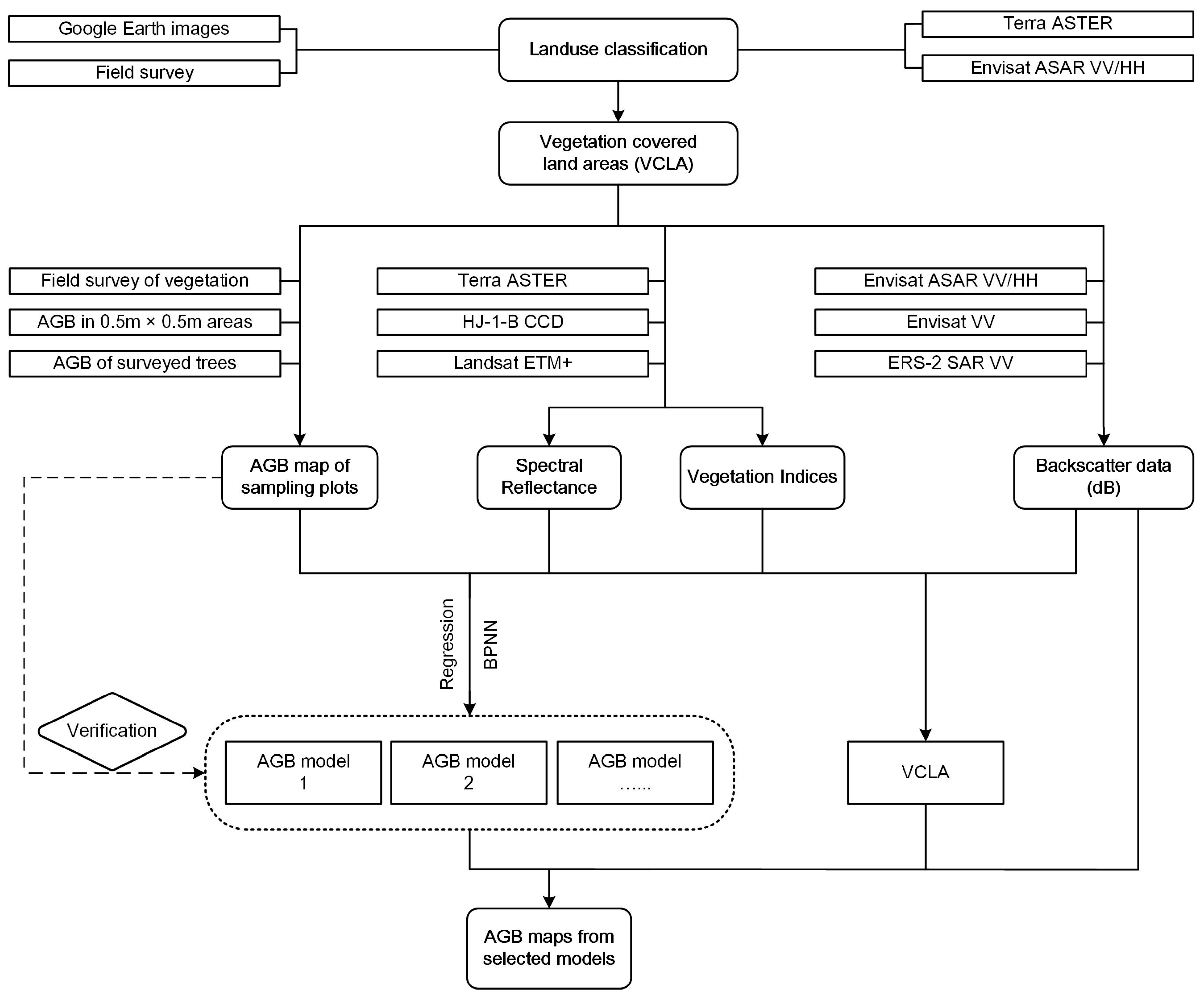
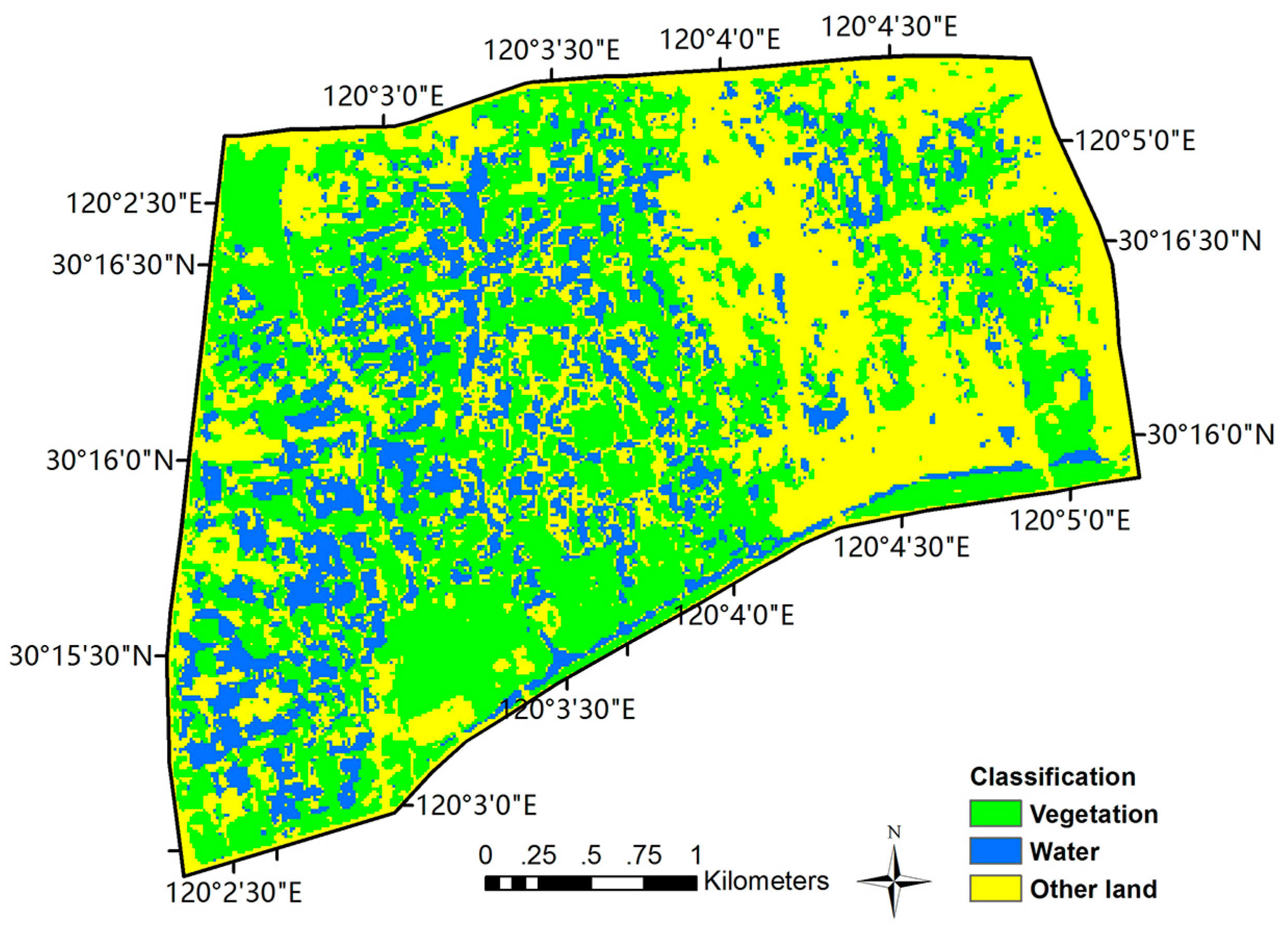
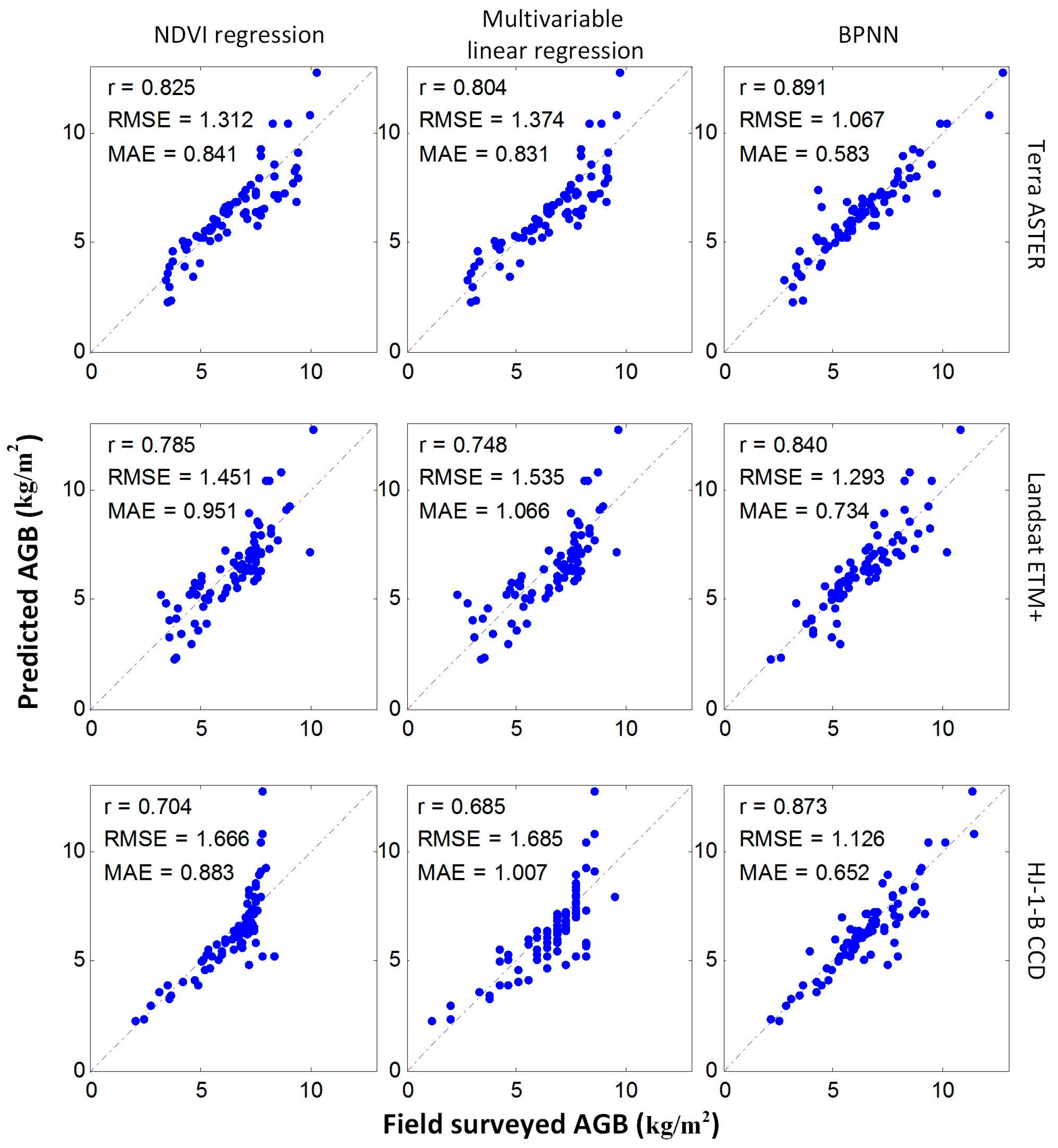

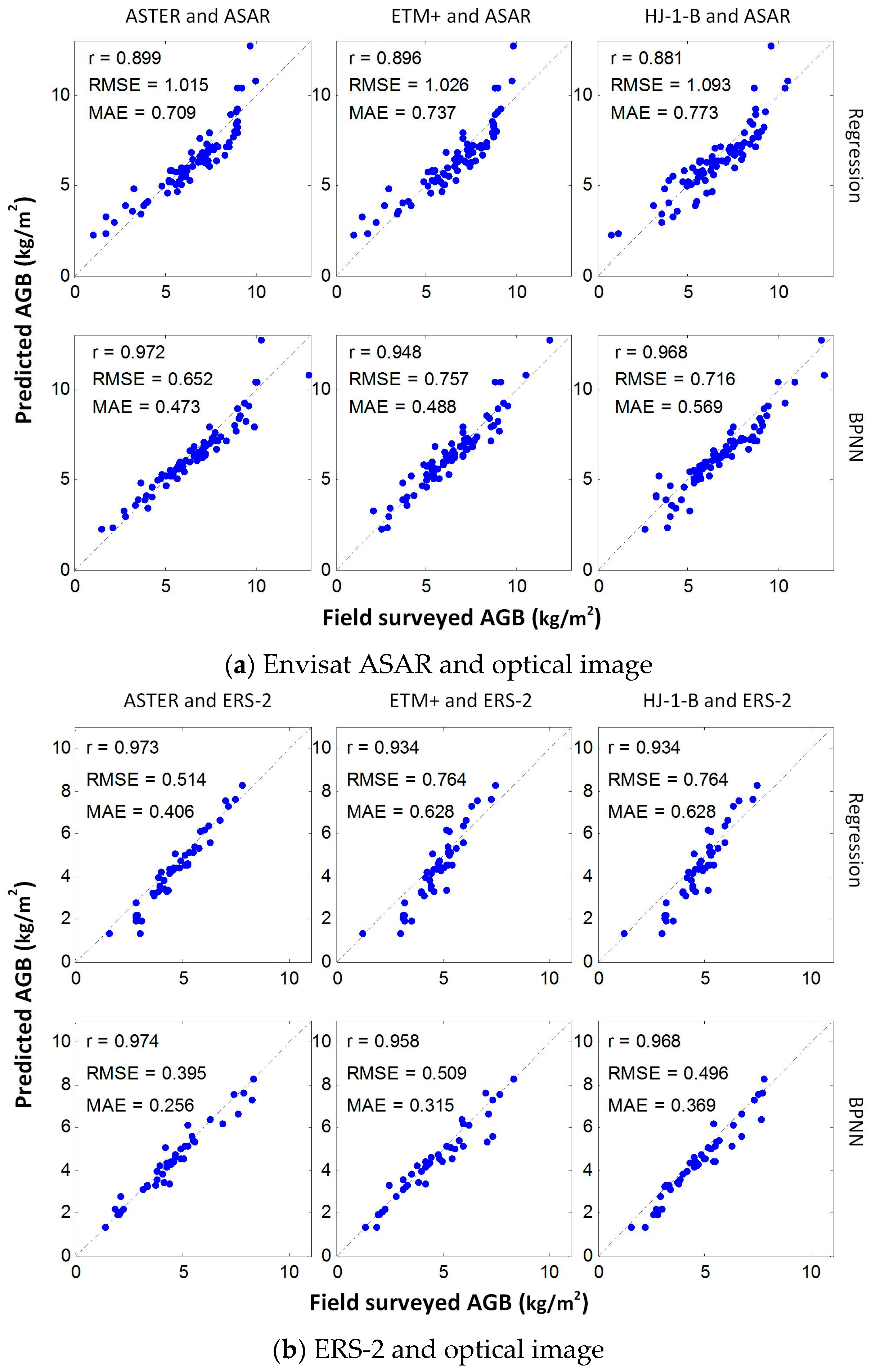
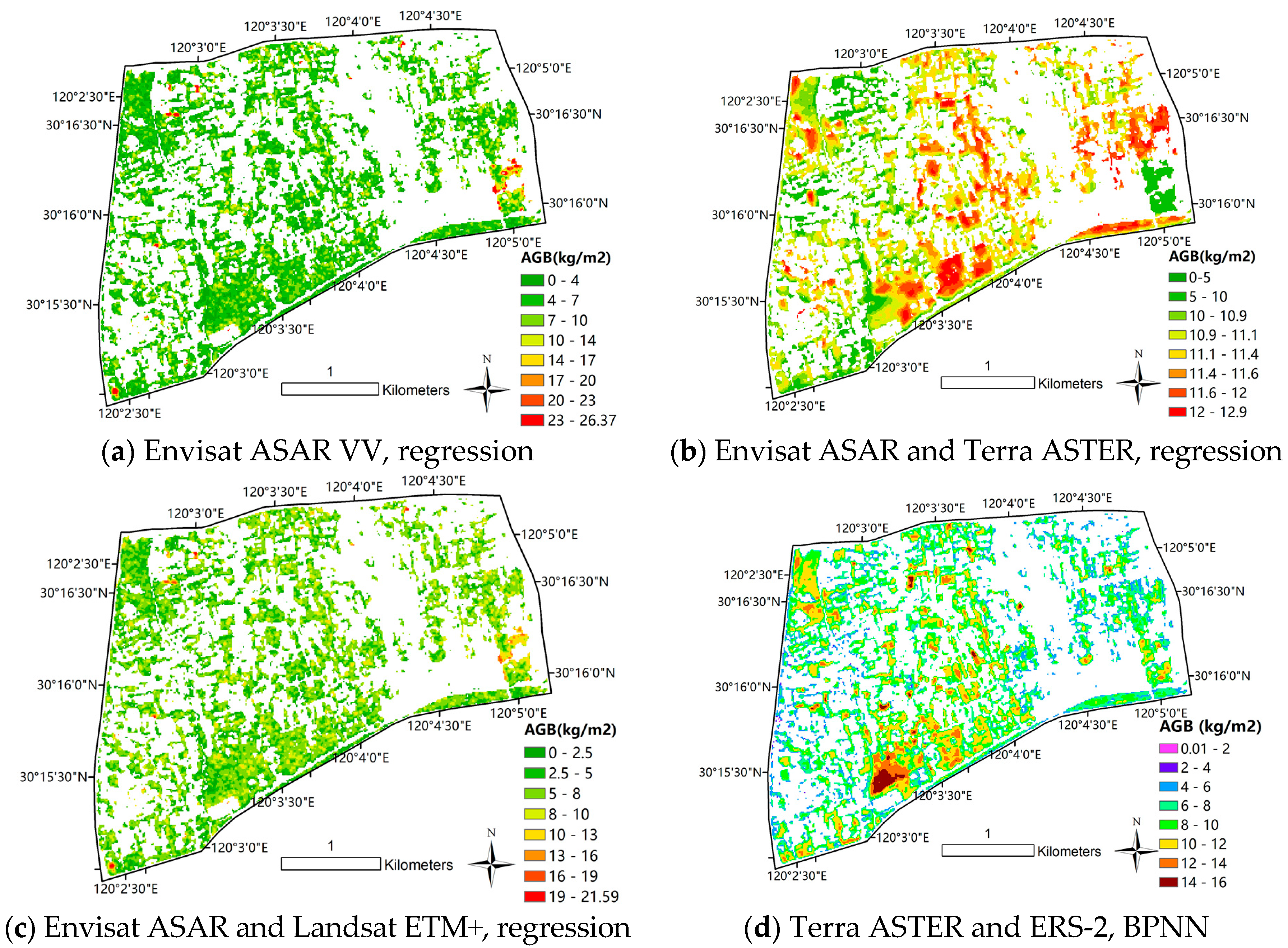
| Sensor Type | Data Type | Pass | Acquisition Date |
|---|---|---|---|
| Radar | Envisat ASAR HH/VV | Ascending | 17 August 2009 |
| Radar | ERS-2 SAR VV | Descending | 22 March 2009 |
| Optical | Terra ASTER | Descending | 16 March 2009 |
| Optical | Landsat ETM+ | Descending | 11 April 2009 |
| Optical | HJ-1-B CCD | Descending | 21 April 2009 |
| (a) Optical-Only Models | |||||
| Input | AGB Model (kg/m2) | R2 | Significance | VIF | |
| Terra ASTER | NDVI | 0.775 | NDVI: 0.000 | / | |
| Spectral reflectance and VIs | 0.642 | NDVI: 0.000 | / | ||
| Landsat ETM+ | NDVI | 0.664 | NDVI: 0.000 | / | |
| Spectral reflectance and VIs | 0.559 | NDVI: 0.000 | / | ||
| HJ-1-B CCD | NDVI | 0.699 | NDVI: 0.000 | / | |
| Spectral reflectance and VIs | 0.548 | NIR: 0.000 | / | ||
| (b) SAR-only models | |||||
| Input | AGB model (kg/m2) | R2 | Significance | VIF | |
| Envisat ASAR | 0.874 | : 0.000 | / | ||
| 0.861 | : 0.000 | / | |||
| , | 0.823 | : 0.000 | : 4.868 | ||
| : 0.000 | : 4.868 | ||||
| ERS-2 | 0.871 | : 0.000 | / | ||
| (c) Envisat ASAR and optical models | |||||
| Input | AGB model (kg/m2) | R2 | Significance | VIF | |
| Envisat ASAR | 0.806 | : 0.000 | : 2.853 | ||
| Terra ASTER | RDVI: 0.040 | RDVI: 2.853 | |||
| Envisat ASAR, Landsat ETM+ | 0.807 | : 0.000 | : 2.117 | ||
| GEMI: 0.039 | GEMI: 2.117 | ||||
| Envisat ASAR | 0.842 | : 0.000 | : 2.136 | ||
| HJ-1-B CCD | RDVI: 0.047 | RDVI: 2.519 | |||
| (d) ERS-2 and optical models | |||||
| Input | AGB model (kg/m2) | R2 | Significance | VIF | |
| ERS-2 | 0.870 | : 0.000 | : 2.965 | ||
| Terra ASTER | RDVI: 0.001 | RDVI: 2.965 | |||
| ERS-2 | 0.841 | : 0.000 | / | ||
| Landsat ETM+ | |||||
| ERS-2 | 0.841 | : 0.000 | / | ||
| HJ-1-B CCD | |||||
© 2016 by the authors; licensee MDPI, Basel, Switzerland. This article is an open access article distributed under the terms and conditions of the Creative Commons Attribution (CC-BY) license (http://creativecommons.org/licenses/by/4.0/).
Share and Cite
Huang, C.; Ye, X.; Deng, C.; Zhang, Z.; Wan, Z. Mapping Above-Ground Biomass by Integrating Optical and SAR Imagery: A Case Study of Xixi National Wetland Park, China. Remote Sens. 2016, 8, 647. https://doi.org/10.3390/rs8080647
Huang C, Ye X, Deng C, Zhang Z, Wan Z. Mapping Above-Ground Biomass by Integrating Optical and SAR Imagery: A Case Study of Xixi National Wetland Park, China. Remote Sensing. 2016; 8(8):647. https://doi.org/10.3390/rs8080647
Chicago/Turabian StyleHuang, Chudong, Xinyue Ye, Chengbin Deng, Zili Zhang, and Zi Wan. 2016. "Mapping Above-Ground Biomass by Integrating Optical and SAR Imagery: A Case Study of Xixi National Wetland Park, China" Remote Sensing 8, no. 8: 647. https://doi.org/10.3390/rs8080647
APA StyleHuang, C., Ye, X., Deng, C., Zhang, Z., & Wan, Z. (2016). Mapping Above-Ground Biomass by Integrating Optical and SAR Imagery: A Case Study of Xixi National Wetland Park, China. Remote Sensing, 8(8), 647. https://doi.org/10.3390/rs8080647








